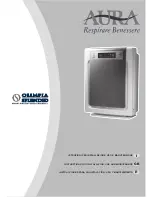
33
32
ENGLISH
ENGLISH
CONGA POPSTAR 10180 ASH
CONGA POPSTAR 10180 ASH
4. OPERATION
Before turning the device on, make sure all the filters are correctly assembled.
Fig. 6
Unwind the power cord
Fig. 7
Plug the device on to a socket and switch it on.
Fig. 8
Unplug the device after use.
Fig. 9
5. CLEANING AND MAINTENANCE
Disconnect the appliance from the power supply and allow it to cool down before cleaning.
Use a soft, damp cloth to clean the product’s surface.
Do not immerse the appliance in water or other liquid.
Do not use abrasive scouring pads, powders or cleaners.
Open the dust tank.
Fig. 2
Remove the high-efficiency filter.
Fig. 10
Empty the dust tank.
Fig. 11
Rinse the high-efficiency filter under water and dry it.
Fig. 12
Fig. 13
Assemble all the components back in place.
Fig. 3
6. TROUBLESHOOTING
Problem
Possible cause
Solution
The engine does not start.
Power cord not plugged into
a socket.
Plug the device on firmly.
Socket damaged.
Check the outlet.
Device not switched on.
Switch the device on.
1. PARTS AND COMPONENTS
FIG. 1
1.
Handle
2.
Suction channel
3.
Dust tank
4.
Switch
5.
Cover
6.
Tank’s lock tab
7.
Suction hose
8.
40-mm XXL metallic nozzle
9.
Metallic nozzle for gaskets
2. BEFORE USE
Take the product out of the box and remove all packaging materials.
Make sure the product is in good conditions.
Inspect all parts of the appliance for visual damage. Unwind the power cord completely and
inspect it for damage. Do not use the appliance if it or its cord have been damaged or are not
working properly.
In case of damage, contact the official Technical Support Service of Cecotec for advise, repairs,
or returns.
Make sure you have read and understood all instructions and warnings in this instruction
manual. Pay particular attention to the safety instructions on previous pages.
3. PRODUCT ASSEMBLY
Assemble the high-efficiency filter to the dust tank.
Fig. 2
Assemble the dust tank to the device.
Fig. 3
Insert one end of the hose to the suction hole.
Fig. 4
Choose an accessory and attach it to the suction hole or the hose.
Fig. 5
















































